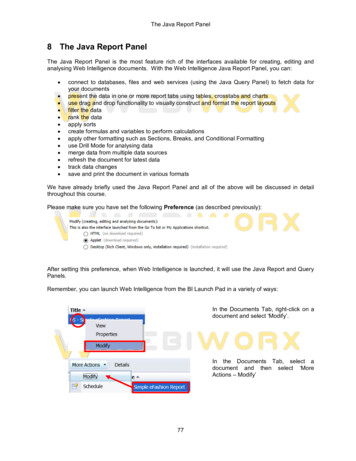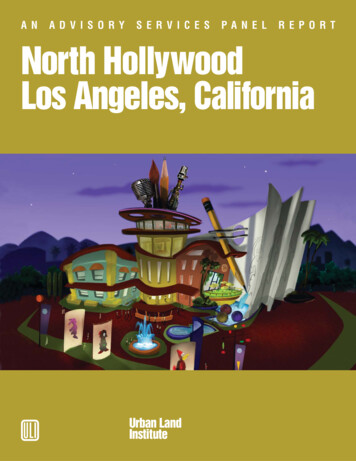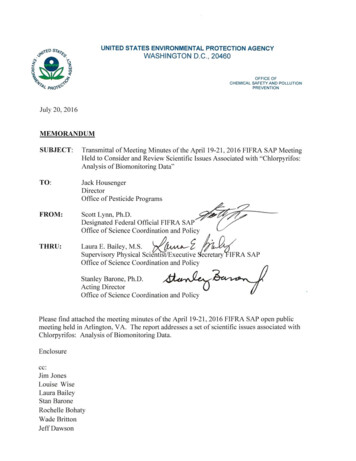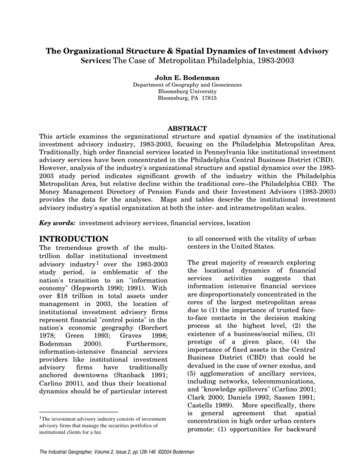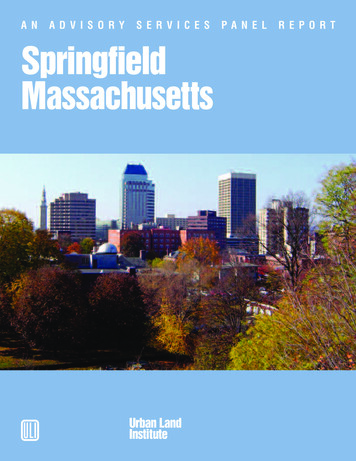
Transcription
A NA D V I S O RYS E R V I C E SSpringfieldMassachusetts Urban LandInstitutePA N E LR E P O RT
SpringfieldMassachusettsStrategies for a Sustainable CitySeptember 24–29, 2006An Advisory Services Panel ReportULI–the Urban Land Institute1025 Thomas Jefferson Street, N.W.Suite 500 WestWashington, D.C. 20007-5201
About ULI–the Urban Land InstituteThe mission of the Urban Land Institute is toprovide leadership in the responsible use ofland and in creating and sustaining thrivingcommunities worldwide. ULI is committed to: Bringing together leaders from across the fieldsof real estate and land use policy to exchangebest practices and serve community needs; Fostering collaboration within and beyondULI’s membership through mentoring, dialogue, and problem solving; Exploring issues of urbanization, conservation,regeneration, land use, capital formation, andsustainable development; Advancing land use policies and design practices that respect the uniqueness of both builtand natural environments; Sharing knowledge through education, appliedresearch, publishing, and electronic media; and Sustaining a diverse global network of localpractice and advisory efforts that address current and future challenges.Established in 1936, the Institute today has morethan 35,000 members from 90 countries, representing the entire spectrum of the land use and development disciplines. Professionals representedinclude developers, builders, property owners, investors, architects, public officials, planners, realestate brokers, appraisers, attorneys, engineers,financiers, academics, students, and librarians.ULI relies heavily on the experience of its members. It is through member involvement and information resources that ULI has been able to setstandards of excellence in development practice.The Institute has long been recognized as one ofthe world’s most respected and widely quotedsources of objective information on urban planning, growth, and development. 2007 by ULI–the Urban Land Institute1025 Thomas Jefferson Street, N.W.Suite 500 WestWashington, D.C. 20007-5201All rights reserved. Reproduction or use of the whole or anypart of the contents without written permission of the copyright holder is prohibited.Cover photo: Office of Planning & Economic Development,City of Springfield.2An Advisory Services Panel Report
About ULI Advisory Serviceshe goal of ULI’s Advisory Services Programis to bring the finest expertise in the realestate field to bear on complex land use planning and development projects, programs,and policies. Since 1947, this program has assembled well over 400 ULI-member teams to helpsponsors find creative, practical solutions forissues such as downtown redevelopment, landmanagement strategies, evaluation of development potential, growth management, communityrevitalization, brownfields redevelopment, military base reuse, provision of low-cost and affordable housing, and asset management strategies,among other matters. A wide variety of public,private, and nonprofit organizations have contracted for ULI’s Advisory Services.Tpants in ULI’s five-day panel assignments areable to make accurate assessments of a sponsor’sissues and to provide recommendations in a compressed amount of time.A major strength of the program is ULI’s uniqueability to draw on the knowledge and expertise ofits members, including land developers and owners, public officials, academicians, representativesof financial institutions, and others. In fulfillmentof the mission of the Urban Land Institute, thisAdvisory Services panel report is intended toprovide objective advice that will promote the responsible use of land to enhance the environment.ULI Program StaffEach panel team is composed of highly qualifiedprofessionals who volunteer their time to ULI.They are chosen for their knowledge of the paneltopic and screened to ensure their objectivity.ULI’s interdisciplinary panel teams provide aholistic look at development problems. A respected ULI member who has previous panelexperience chairs each panel.William P. KistlerExecutive Vice President, Exchange GroupThe agenda for a five-day panel assignment is intensive. It includes an in-depth briefing day composed of a tour of the site and meetings with sponsor representatives; a day of hour-long interviewsof typically 50 to 75 key community representatives; and two days of formulating recommendations. Many long nights of discussion precede thepanel’s conclusions. On the final day on site, thepanel makes an oral presentation of its findingsand conclusions to the sponsor. A written report isprepared and published.Carmen McCormickPanel Coordinator, Advisory ServicesBecause the sponsoring entities are responsiblefor significant preparation before the panel’s visit,including sending extensive briefing materials toeach member and arranging for the panel to meetwith key local community members and stakeholders in the project under consideration, partici-Martha LoomisDesktop Publishing Specialist/GraphicsSpringfield, Massachusetts, September 24–29, 2006Rachelle L. LevittExecutive Vice President, Information GroupThomas EitlerDirector, Advisory ServicesNicholas GabelSenior Associate, Advisory ServicesYvonne StantonAdministrative AssistantNancy H. StewartDirector, Book ProgramLaura Glassman, Publications Professionals LLCManuscript EditorBetsy Van BuskirkArt DirectorKim RuschGraphicsCraig ChapmanDirector, Publishing Operations3
AcknowledgmentsLI–the Urban Land Institute has been privileged to join with the people of Springfieldin an Advisory Services panel to explorestrategies to renew and sustain a vibrantcommunity. Bringing a panel to the city is a majorundertaking, one made possible by the dedicatedefforts of many people. Organizing the effort werethe panel’s chief sponsors, the city of Springfield,the Springfield Finance Control Board, the Springfield Chamber of Commerce, the Economic Development Council of Western Massachusetts,MassDevelopment, and the Pioneer Valley Planning Commission.Uated Chambers of Commerce of Greater Springfield. The panel would also like to thank GlennBurdick, chair, and Tracy Smith, coordinator, ofthe ULI New England District Council.The panel would particularly like to thank MayorCharles Ryan and his staff; Phil Puccia, DavidPanagore, and the members and staff of the Springfield Finance Control Board; Russ Denver andCarol Baribeau of the Springfield Chamber ofCommerce and its sponsoring members; AllanBlair, Al Griggs, and the membership of the Economic Development Council of Western Massachusetts; and Robert Culver, president and chiefexecutive officer of MassDevelopment and hisstaff for their contributions as members of thecity’s ULI Steering Committee, the preparationof panel briefing materials, and the panel’s comprehensive tour of the city.Several corporate sponsors helped make this panelpossible. Special thanks go to American International College; Bacon & Wilson, PC; Balise MotorSales Co.; Bank of Western Massachusetts; BaystateHealth; Brightwood Development Corporation;Bulkley, Richardson, and Gelinas, LLP; C & WRealty Co.; Chase Clarke Stuart & Fontana, Inc.;Disability Management Services; Doherty, Wallace, Pillsbury, & Murphy; Eastfield Mall; Field,Eddy, & Bulkley, Inc.; Friendly Ice Cream Corporation; Garvey Communications Associates;Hampden Bank; HAP, Inc.; Irene E. & George A.Davis Foundation; Massachusetts ConventionCenter Authority; MassMutual Financial Group;Monarch Enterprises; Moriarity & Primack, PC;Peoples Bank; Peter Pan Bus Lines, Inc.; PrideStations & Stores; Robinson Donovan, PC; SamuelD. Plotkin & Associates; Sisters of ProvidenceHealth System; Sovereign Bank of New England;Springfield Chamber of Commerce; SpringfieldCollege; Springfield Technical Community College;TSM Design; United Bank; Verizon; WMECO;Western New England College; and Westfield Bank.The ULI Advisory Services panel process requireshard work on the part of the sponsor as well aspanelists. The panel is grateful to the membersof the city’s ULI Steering Committee: TimothyBrennan and Paul Foster, Pioneer Valley PlanningCommission; Michelle Webber, Office of the Mayor;Katie Stebbins, Springfield Office of Planning andEconomic Development; Scott Hanson and PhilDromey, Springfield Office of Planning and Economic Development; Richard Henderson, SeanCalnan, Elizabeth Murphy, and David Websterof MassDevelopment; Eric Nakajima, DonahueInstitute, University of Massachusetts; NancyUrbschat, TSM Design; Ivette Cruz, Office ofHousing and Neighborhood Services; Jason Mannand Cathy Mossi, city of Springfield; and AltaStark, Lynn Johnson, and Jeff Ciuffreda, Affili4Conducting a panel requires the use of severalvenues and services. The panel would like to thankthe following institutions for providing meetingspace, food, or services: the Carriage House at theBarney Estate, CityStage, the Colony Club, theFort, Frigo’s, the MassMutual Center, Peter’s GrillePrime Steakhouse, the Pioneer Valley TransitAuthority, the Sheraton Springfield Hotel, andSonoma Bar & Grill.Finally, the panel members are grateful to themore than 140 community residents, businessleaders, public officials, employers, and educational and cultural leaders who willingly gave oftheir time to be interviewed by the panel. Theirinsights and candor were particularly helpful inthe panel’s understanding of the current situationin the city of Springfield.An Advisory Services Panel Report
ContentsULI Panel and Project Staff6Foreword: The Panel’s Assignment7Leadership: Public, Private, and Community11Planning and Development Strategies16Downtown Market Potential22Downtown Design Elements and Key Projects29Conserving Springfield’s Neighborhoods35Neighborhood Priority Projects40Conclusion42About the Panel43Springfield, Massachusetts, September 24–29, 20065
ULI Panel and Project StaffPanel ChairMaureen McAveyExecutive Vice President, Initiatives GroupUrban Land InstituteWashington, D.C.Panel MembersLewis BolanPrincipalBolan Smart Associates, Inc.Washington, D.C.Elizabeth B. DavisonDirectorMontgomery County Department ofHousing and Community AffairsRockville, MarylandBarry ElbasaniPresidentELS Architecture and Urban DesignBerkeley, CaliforniaEllen M. McLeanPartnerM2 ConsultingPittsburgh, PennsylvaniaAlvin McNealSenior Vice PresidentFraser Forbes Company, LLCMcLean, VirginiaULI Project DirectorDeborah L. MyersonPrincipalDeborah Myerson Planning &Development ConsultingBloomington, IndianaULI On-Site CoordinatorGerri TennysonConsultantPatrick FoxPresidentSaint Consulting GroupHingham, MassachusettsJeff KaplanAssociateWulfeUrbanHouston, TexasRaymond L. Kuniansky, Jr.Citiesouth Group, LLCAtlanta, Georgia6An Advisory Services Panel Report
Foreword: The Panel’s Assignmenthe city of Springfield is at a pivotal point indetermining its future. It has an opportunity to overcome past troubles and realizeits potential as the region’s urban and cultural center. Local leaders and citizens must makethe following decisions:T How should the city capitalize on its assets andmake the most of its community and economicdevelopment efforts? How should the city prioritize its planning anddevelopment efforts?IntroductionLeadership is at a critical transition point. The firstitem of business that citizens must address is howto rebuild the civic foundation of the city of Springfield into something vibrant and sustainable. Residents and workers must commit to building a newcity, recognizing the strengths and assets of whatis here, celebrating the energy and investment ofnew residents. In today’s competitive environment, Springfield will not thrive and succeed if itspeople do not come together, share a common vision, and get about the business of implementingthat vision with a steady and committed hand.Next, the city must consider how to strengthenand diversify its downtown. The panel has identified Springfield’s rich potential as the urban andcultural center of the Pioneer Valley. The Brookings Institution recently completed research onmore than 200 metropolitan areas of the UnitedStates. Virtually no metropolitan area is strong ifits central city is not strong. Safety and the perception of safety—especially as actual crime levelsare dropping—are threshold issues for employers,residents, and visitors alike. Many developmentand redevelopment projects have lingered on drawing boards for too long. Key projects, able to servea catalytic role in rebuilding the city, must be initiated at once and followed through to completion.Springfield, Massachusetts, September 24–29, 2006Lasting improvement will take more than the goodwork of a few. The panel heard that the city hasbeen known as both the “City of Homes” and the“City of Grudges.” The City of Homes needs tobe rekindled, and the City of Grudges needs to bepermanently buried. Springfield must pursuestrategies to realize the rich potential of its downtown and secure its place as a vibrant urban centerand cultural hub for the region. A strong downtownwill, in turn, be a vital support for the livelihoodof the city’s neighborhoods and provide an inducement for redirecting new retail, entertainment,office, and housing growth that has been movingto the suburbs.The strong neighborhood associations must lookbeyond the borders of their own communities andengage in new ways with local and regional businesses, with local and state government, and withthe media. The government and Finance ControlBoard cannot do this work alone. With a sharedvision of the future, people can focus on the tasksat hand and move on. Focusing on the past—whatcould have, should have, or might have been done—will not help the city move forward. EveryoneSpringfield's musical andartistic attractions, suchas the Dr. Seuss sculpturegarden, make it a culturalhub for the region.7
Location map.N EW HAMPSHIREV E R MON T49593LowellA t l a n t i cO c e a n495HIRM ASSACHUSETTS495Massachusetts BayCambridge BostonKSWorcesterER B 9591 E HILLS Albany NE W Y ORK9390 909095Springfield39584ITY495CCape Cod BayCONNE CTICUTRKProvidenceRHODEISLAN cket Sound15New HavenRhode Island SoundBridgeportGardiners BayStamfordLong Island SoundN EW YORKNapeagueBayloses. Springfield has a comeback story to tell. Itneeds help from a variety of partners if the storyis to have a happy ending. Those potential partners must be engaged, educated, and enthusiasticabout making Springfield what it can be in the future, a thriving urban hub in the heart of the Pioneer Valley.Springfield has important decisions to make. Thecity has great resources: beautiful buildings, 35parks, and lovely rivers and ponds. Several majoremployers call the city home. Small businesses findthe city a great place for a startup. Most of all,Springfield has its people. Although the city hashad its challenges and troubles in recent years, thepeople of Springfield continue to have great pridein their city and are struggling to improve it.The city must work for all, new resident or old, wellconnected or not. Transparency and ethical behavior must be the norm, not the exception. The hard,tough work being done now by the Financial Control Board must continue until community valuesand practice meet the highest expectations of thepeople who love this city so deeply.The AssignmentSpringfield is strategically located approximately35 miles north of Hartford, Connecticut, 90 mileswest of Boston, and 150 miles northeast of NewYork City. The city serves as a gateway to the8popular vacation area of the Berkshires. It is partof the financial, medical, and educational center ofwestern Massachusetts.Over the past 15 years, both good things and badhave happened in Springfield. In 1992, state funding was changed and Springfield lost approximately 80 percent of its nonschool state aid, crippling local services. Over the years, crime hasincreased as gangs and drug trafficking gained afoothold in the city. Some middle-class residentschose to move to the suburbs, as in other communities nationally. Some neighborhoods have startedto slide. Development projects floundered, andcorruption crept into segments of the public sector. Neighborhoods seemed to turn inward ratherthan embracing the entire city and region.On the positive side, primary businesses have continued to expand: MassMutual Financial Group andBaystate Health have continued expansion withinthe city. Downtown has seen significant new regional cultural and civic spaces with the buildingof the convention center and the addition and expansion of new museums. City leadership has beenrekindled. Business leaders are again taking holdand discussing new projects and investments. Thestate of Massachusetts has stepped in and assistedthe city with support in the form of the SpringfieldFinance Control Board. It is a new beginning.An Advisory Services Panel Report
At this important juncture, the city asked theUrban Land Institute to convene a five-day Advisory Services panel to address specific issues confronting Springfield. The panel’s assignment wasboth broad and targeted to certain developmentprojects. The city asked the panel to undertakethe following: Consider the current position of Springfield, itsassets and opportunities, and its existing liabilities. Suggest a strategy for the city to leverageits available resources and encourage economicdevelopment, prioritizing its short-term, midterm, and long-term planning and development efforts. Identify changes in current economic development programs and the process and approach toimprove the quality and quantity of private investment, increase home ownership, and reduce crime. Analyze and assess public projects that mighthave the greatest potential in the near term forSpringfield. Consider improved physical links within thedowntown, between downtown and the riverfront, and between the downtown and theneighborhoods. Identify effective structures to carry out thestrategies identified by ULI. Suggest the panel’s view of Springfield’s marketand role within the region. Comment on economic development options regarding the expansion of the existing industryclusters, health, financial services, education andtourism/arts. Identify measures to support thosestrategies. Discuss how to balance economic development efforts between attracting new companies and retaining existing companies.Summary of RecommendationsIn light of these issues, the panel makes the following major recommendations: Encourage strong community leadership fromthe highest level to step forward. Leaders at thehighest levels, across all sectors—public, priSpringfield, Massachusetts, September 24–29, 2006vate, and community—must commit and engagepositively for Springfield’s success. Leave the Springfield Finance Control Boardin place for another term. Much needs to bedone in a relatively short time frame for the cityto regain its credibility and become a good placeto live and invest. The control board has hadsubstantial success, retaining a respected policecommissioner who is already showing results,resolving lingering labor contracts, and balancing the budget. The efficiency and effectivenessof the control board can assist the city over thenext few years in focusing on tasks, not politics.New leadership needs to emerge to carry onwhen the control board steps aside.Assisting the growth anddevelopment of existingsmall businesses inSpringfield stands to be amuch stronger economicdevelopment tool thannational or regionalrecruiting efforts. Make downtown the urban center of the PioneerValley, a great place to live, work, and play. Reducing crime is a threshold issue. Encouragingmarket-rate housing, additional amenities, andultimately more retail and entertainment willmake Springfield what it can be, not a stepsisterto other towns in the valley. Embrace diversity throughout city. Springfieldhas a rich ethnic and racial diversity that, withbroad engagement of the representative public,is a critical foundation for future progress. It istime to celebrate what Springfield is, not bemoan what Springfield is not.9
Leaders at the highestlevels, across all sectors—public, private, andcommunity—must commit and engage positivelyfor Springfield's success. Conserve Springfield’s neighborhoods. As the“City of Homes,” the city should engage itsmany civic and neighborhood associations tosupport efforts to protect the architecturalcharacter of the city’s residential neighborhoodswhile also building a shared sense of community.Although many projects may be viable over time,the panel believes that Springfield’s highest attention should be given to the following efforts: Solidify downtown as the preeminent employment, urban, cultural, and visitor center for thePioneer Valley. Such efforts include: Adding more market-rate housing in a variety of housing types to meet the market, suchas lofts, townhomes, condominiums, and single-family homes. Focusing attention on Court Square, including the redevelopment of the historic formerCourt Square hotel building. The groundlevel uses and appearance of these buildingsare important to encourage pedestrians andmore-walkable connections in downtown.reuse of the building would be for classroomsor a student center for one of the locally basedcolleges, which would bring energy and activity to downtown. Demolish the York Street jail. The jail is a keydowntown property that has languished for toolong and stands as an extremely visible symbol of downtown stagnation. After the site iscleaned up and vacant, it will be available forthe right development opportunity. Develop a plan and implementation strategy forthe Gemini-Hollywood area in the South Endneighborhood. Redevelopment of this area canbe a catalyst for neighborhood revitalization.This area can and should become a thrivingcommunity with a mix of incomes and housingchoices. Necessary steps for the revitalizationof the South End neighborhood include thinking of the area in its totality, not just as isolatedprojects; reducing crime; reducing density inthe Hollywood project and providing off-streetparking and play space; and encouraging agood mix of neighborhood-oriented retail onMain Street. Planning for the adaptive reuse of the Federal Building on Main Street. The city shouldgain control of the site and ensure that thesite is used in a manner that will supportdowntown revitalization efforts. Optimal10An Advisory Services Panel Report
Leadership: Public, Private,and Communityhe city of Springfield is at a turning pointwith respect to its future, and everyone—public officials, business leaders, communityorganizations, and residents—must be involved in the choices at stake. These choices muststart with the commitment of community leadersto renew Springfield, promote good government,engage the diversity of its population, and achievefinancial stability. Some preconditions necessaryfor successful community development to occur inSpringfield include the following:TTo thrive as a community and ensure that Springfield’s turnaround is enduring, Springfield’s citizenry must insist that at the city’s highest levelsall business leaders step forward to identify, embrace, and opt into a plan to revitalize this greatcity. Strong leadership is imperative to create longterm, sustainable financial stability in Springfield.Leadership must also support Springfield’s plansto create jobs, to encourage investment, and topromote growth equitably across the whole city. Effective local government support;Government cannot be responsible for all things,however. Many more of its citizens must committo stand up and help Springfield move forward.Such improvement requires public/private partnerships that reflect the city’s diversity. Going forward, business and neighborhood leaders mustcommit to engage positively toward the achievement of a well-defined plan for economic health.Inclusivity is key to Springfield’s success. Thiscity’s wonderful ethnic and racial diversity mustinform the agenda for progress and serve as a critical principle in engaging the public. A culture fostering local civic pride and corporate philanthropy; Sustained efforts to fight cynicism; Visionary developers; Regional cooperation; and A strong focus on economic development andwith dedicated staff to initiate and sustainthese efforts.Encourage Strong CommunityLeadershipAs the panel interviewed residents, business andinstitutional leaders, and community activists,panel members were struck that no common vision exists of either what is “wrong” with the cityor how to put it “right.” Without a common vision,the necessary changes and identification of priorities are difficult to achieve. The leaders of the city,from its communities, businesses and institutions,and civic leadership (elected and appointed) mustcome together to work out a common sense of therole of the city and its desired future. Strong community leadership must step forward from thehighest levels (see Figure 1).Springfield, Massachusetts, September 24–29, 2006To achieve Springfield’s potential and establish arenewed civic foundation, the panel recommendsthe following: Renew the Springfield Finance Control Boardfor another term. Resolve inequities in nonschool state appropriations to Springfield. Reshape community attitudes for a positive outlook on Springfield’s future. Create and promote guiding principles for goodgovernment. Seek inclusiveness and celebrate diversity.11
Medicare and the adoption of the state’s healthcare plan;Figure 1Leadership for a Sustainable SpringfieldPrivate Sector Business leaders Nonprofit organizationsPublic Sector Finance Control Board MassDevelopment Elected representatives City staffCommunity Citizens Neighborhood associationsExtend the Term of the SpringfieldFinance Control BoardOutstanding work has been done—and continuesto be done—by the Springfield Finance ControlBoard (SFCB) and the city under the leadershipof Mayor Ryan. With many of the worst of itsproblems behind it, the city is well on the way torecovery. Thanks to massive belt tightening, fiscalrestraint, new labor contracts, new and improvedmanagement tools, and just plain hard work onthe part of many dedicated and talented people,the city is at or near fiscal solvency. It is dealingeffectively and realistically with its key problemsand key issues. Crime rates are beginning to decline. Municipal services are being improved, andfaith is being restored in local government.The SFCB, with the city, has made significant progress in a relatively short time. First and foremost,the business of government is now being conductedwithin the highest legal, moral, and professionalstandards. The strong partnership between theSFCB and Mayor Ryan has resulted in the achievement of significant wins: A positive year-end 2006 cash balance; The signing of fixed, long-term labor agreements going out six to seven years; Significant health care savings through the reassignment of Medicare-eligible employees to12 Significant improvements to delinquent tax collection, resulting in collection of 21.5 million, or47 percent, of the city’s tax title portfolio; Implementation of crime prevention strategiesby the new police commissioner to address fearand disorder and to build strong police and community relations; Citywide departmental audits and assessmentswith strategic action plans that seek to automate services and encourage efficiencies; Strong commitment to economic developmentwith appointment of a chief development officer; Deployment of significant resources to improveschool facilities and academic performance; and Highly qualified professional senior managersselected both from within and from beyond thelimits of the city’s boundaries.Significant work remains for the SFCB, however, if Springfield is to right the ship for its longterm sustainable recovery. The SFCB must remain in place for another term to continue to makeprogress on these efforts. Despite fixed long-termlabor contracts and significant constraints won onhealth care growth, Springfield’s fiscal stability isfragile. Expenses continue to rise at a rate greaterthan revenues. Economic development and community growth must occur to create jobs, encourage investment, and promote growth equitablyacross the city. New initiatives for policing musttake hold.The panel also heard from several intervieweesthat improvement in city schools, both in academics and operational performance, is needed ifSpringfield is to attract families into its borders.Additionally, strategic action plans for coordinateddelivery of health and human services among agencies is imperative as Springfield continues tostruggle with social issues related to drug addiction, homelessness, poverty, and the like.The SFCB and the city must continue together tostrengthen Springfield’s financial position. Cashbalances are not nearly sufficient. More time isneeded to streamline operations to deliver the mostefficient and effective services to the residents ofAn Advisory Services Panel Report
Resolve Inequities in StateAppropriations to SpringfieldOne immediate agenda item that must be a priority for the leadership in the Springfield communityis righting the method used to allocate dollars inthe state’s Additional Assistance program. Stateallocation of Additional Assistance dollars is woefully out of balance.Last year, Springfield—the third-largest city inMassachusetts—ranked 36th among municipalitiesreceiving funds from the Additional Assistanceprogram, which is one of two major sources of nonschool aid. Distributions statewide from this program were reduced in the early 1990s and haveremained relatively flat since then, but initial reductions were inexplicably applied. Where Bostonand Cambridge experienced reductions in Additional Assistance in 1992 of 18 percent and 21 percent, respectively, Springfield’s reduction in 1992was 84 percent. In 1991, Springfield received 14.3 million in
4 An Advisory Services Panel Report ULI-the Urban Land Institute has been privi-leged to join with the people of Springfield in an Advisory Services panel to explore strategies to renew and sustain a vibrant community. Bringing a panel to the city is a major undertaking, one made possible by the dedicated





